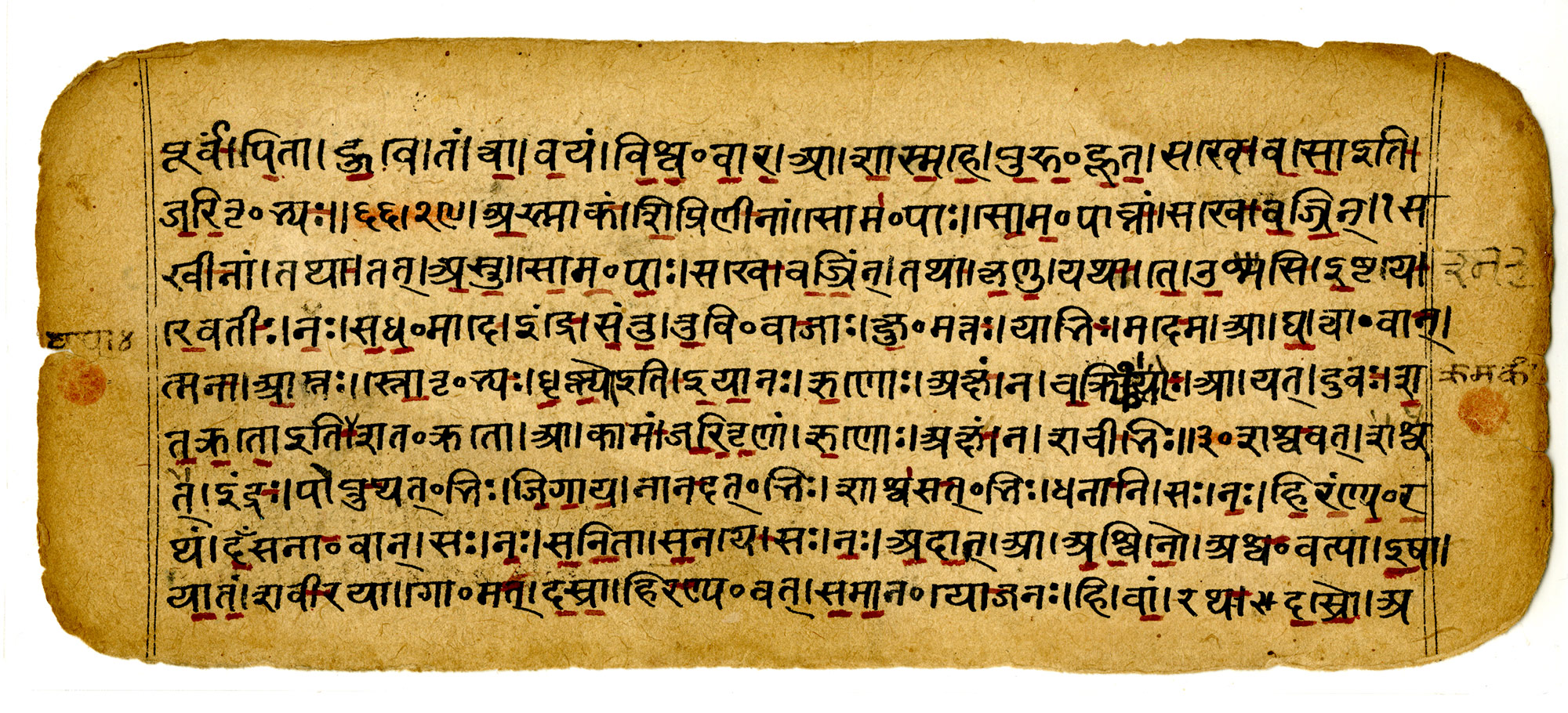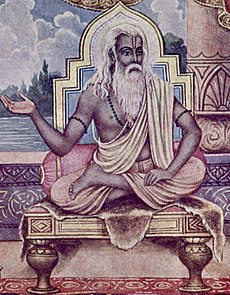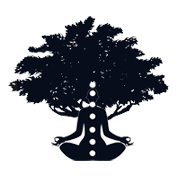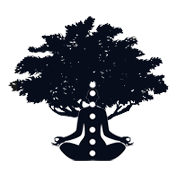The Vedas
Vedas are respected as the most sacred books of Hinduism since the beginning of the history of ancient Indian culture, religion, and philosophy. The modern culture of India a country with the world’s largest population is a variant of Vedic culture. Almost everything relating to the Indian way of life finds its roots in the ancient knowledge enshrined in Vedas in the form of sacred hymns.
Vedas are the most sacred yet most controversial books for Hinduism. There is no agreement on the nature and purpose of the texts, their date, or the origin of the people who composed them. Many absurdities have crept in throughout thousands of years. The Vedic hymns are ambiguous and use metaphors in many places; hence it is not easy to make sense of them, and it won’t be wrong to say that no one can understand Vedas by merely reading them or translating them. But the Vedas choose to reveal themselves to the one who intends to go beyond translation and ponders over the hymns to figure out the meaning of what Vedic Sages and Seers have tried to describe.
Yet Vedic culture, perhaps, is the only ancient culture that is very much alive and vibrant and continues to contribute to shaping the ethos of the Indian culture not just in India but across the globe. They are the highest Hindu authorities.
Vedas are divided into two great classes, called Sruti and Smriti. Sruti means hearing and implies direct revelation. These texts were “heard” by composers and conveyed to them from the divine source. Smriti means “recollection.” These books were composed by human authors.

Image Copyright © Wikimedia Commons
Vedic literature is broadly classified into Samhitas, Brahmanas, Aranyakas, and Upanishads. The four Vedic Samhitas are: -
- Rig Veda: - The word “Rig” comes from the Sanskrit word “Rik” and means to celebrate. Rig Veda contains hymns praising Vedic gods, including Indra, Agni, Ashwini Kumars, and Vayu. Rig Veda the hymns or Suktas are arranged into ten mandalas subdivided into more than a hundred Anuvakas or sub-sections. A further sub-division of the Suktas into Vargas, or paragraphs. Every word of Rig Veda has been carefully counted as early as 600 BC. Rig Veda has around 153,826 words and 10,600 verses. The first seven mandalas have hymns dedicated to Agni. After the hymns to Agni and Indra, we find hymns dedicated to Vishwa Devas.
- Yajur Veda: - The word “Yajur” comes from the Sanskrit word “Yaj,” which means sacrifice. Yajur Veda contains hymns and prayers for preparing the ground and utensils for sacrificial worship. It has about half the number of hymns found in Rig Veda, and its contents are not entirely taken from Rig Veda. Yajur Veda contains around 1875 verses. Yajur Veda is divided into two parts the white (Shukla) and the black (Krishna) Yajurveda. The great Sage Ved Vyasa had many disciples; the chief among them was Vaisampayana. After completing his studies with Ved Vyasa, Vaisampayana established a Shakha or School to impart Vedic knowledge to others. He was a great teacher of Krishna Yajurveda. Vaisampayana had a student named Yajnavalkya, who was a brilliant intellectual. But Yajnavalkya was proud of his abilities and achievements. There is a story where Vaisampayana asked Yajnavalkya to perform penance on his behalf with other students, and Yajnavalkya refused to do so. The Guru Vaisampayana became angry on hearing this and asked Yajnavalkya to return all knowledge about Yajurveda he had received from him. It is described that Yajnavalkya vomited out the Yajurveda. The Thithiri birds ate the vomit and began to recite the Vedic hymns, which came to be known as Taithriya Samhita. Yajnavalkya realizing his mistake, started penancing for Surya Deva (the Sun God). The Surya Deva then imparted the knowledge of Yajurveda to Yajnavalkya, which is called white or Shukla Ayurveda because it came from the Surya.
- Sama Veda: - Sama Veda is the smallest Veda. It is around half the size of Yajur Veda. It contains 1549 verses. Most of the verses in Sama Veda have been selectively taken from Rig Veda. Many of the verses are addressed to Soma, some to Agni, and some to Indra. The importance of Sama Veda is understood from Bhagwad Geeta, where Shri Krishna says, “Among the Vedas, I am Sama.”
- Atharva Veda: - Atharva Veda contains around 2000 verses. Atharva Veda consists of verses concerning magical spells to ward off evil spirits or danger, chants, hymns, prayers, initiation rituals, marriage and funeral ceremonies, and destroying enemies.
Each Vedas is further divided into Aranyakas, Brahmanas, and Upanishads. The word Arayankas means “belonging to the forest.” These scriptures should be read in the forest or a modern world, away from crowded cities and somewhere close to nature and calm. These scriptures, along with Brahmanas, explain the mystical sense of ceremonies and the nature of God. Upanishads are the last composed layer of text on Vedas and are often referred to as “Vedanta.”
The Authors of Vedas
Vedas are Sruti which means they have been heard. It is believed that the great “Seers” or “Rishis” heard Vedas as divine revelation from the Supreme Being, the Brahman or the God, which means Vedas are eternal. They existed with the Supreme Being or Brahman before the beginning of time. At the beginning of each Kalpa, they are revealed by the Brahman to Brahma, and Brahma tells the Vedas further to the Rishis. Though revealed to various “Seers,” Vedas were compiled and arranged by the great Sage Ved Vyasa, who put all verses in their present form in different Samhitas. Ved Vyasa further taught each of the Samhitas to one of his pupils, and they taught them further to others.

Why do we find absurdities and ambiguities in Vedas?
The most common complaint we find from people questioning Vedas is regarding absurdities and ambiguities in Vedas. Well, in reality, no one can deny that there are absurdities and ambiguities in Vedas. Still, to understand the reason for these absurdities, we need to investigate the history and culture of ancient India and Hinduism.
Vedas are ancient: - Vedas are the most ancient texts known to humanity. The verses of Rig Veda were written in the language of the time. Historically it is considered that they were written around 1500 BCE to 1200 BCE. In the time of Buddha, around 500 BCE. Sanskrit ceased to exist as a spoken language. Panini’s Sanskrit grammar was composed between the 7th and 4th centuries BCE. The Sanskrit language of Rig Veda has a more extensive collection of grammatical forms and rules to join words, and some of the letters in the verses are marked with accents. To add to the difficulty is the fact that Vedas use metaphors to describe deep logical meanings and explanations. This makes it difficult to establish if the meanings of the words are the same as in classical Sanskrit.
Oral traditions in Hinduism: - A significant reason that some people feel a lack of authenticity about verses of Vedas from a historical perspective is the oral traditions of Hinduism. For centuries Vedas were transferred to the next generation entirely by memory. In the ancient gurukul traditions, the Guru imparted knowledge to the pupils through speech. The pupils used to learn the Vedas by heart during 12 years of studentship or Brahmacharya. Understandably, the Vedic verses were lost and corrupted over the centuries. Even though the practice was supposed to protect the Vedas from corruption, it allowed ambiguities to creep into them because there were no written records. From a historical perspective, no date in ancient Indian history can be obtained with certainty until Chandra Gupta, about 300 BCE, which makes it challenging to establish events related to compiling Vedas with great confidence.
How much of the knowledge in Vedas is lost already?
एकविंशतिभेदेन ऋग्वेदं कृतवान् पुरा ।
शाखानान्तु शतेनैव यजुर्वेदमथाकरोत् ।।
सामवेदं सहस्रेण शाखानां प्रविभेद स ।
अथर्वाणमथोवेदं विभेद कुशकेतन ।।
भेदैर्ष्टादशैर्व्यासः पुराण कृतवान् प्रभुः ।
सोऽयमेकश्चतुष्पादो वेदः पूर्वं सनातन ।।
As per Kurma Puran, Initially, Vyasa composed the Rig Veda with twenty-one branches, while Yajur Veda had a hundred branches. Sama Veda had a thousand branches. Atharva Veda was also distributed in nine branches. Ved Vyasa also created Puranas with eighteen branches. Ved Vyasa divided the eternal Veda into four branches. We can see here that more than 1000 divisions of the knowledge of Vedas were there. But we have only 12 divisions of the knowledge of Vedas surviving to date. Simple maths tells us that around 99% of Vedic knowledge is already lost in time.
Conclusion
Vedas have stood the test of time and even in this age of information, computers and scientific achievements Vedas can still answer the most profound questions mankind still faces concerning philosophy and metaphysics, like the concept of God, soul, and nature, where consciousness comes from. How the Universe was made? Who am I? Why are we here? Where are we going? We will be exploring these concepts in later articles.
Citations: -
- J.m.mehta. Divine Message Of God To Mankind Vedas. N.p.: Pustak Mahal, (n.d.).
- Phillips, Maurice. The Teaching of the Vedas: What Light Does it Throw on the Origin and Development of Religion? United Kingdom: Longmans, Green, 1895.
- Griffith, R. T. (2003). The Vedas with Illustrative Extracts Addressed to Thoughtful Hindus. The Book Tree San Diego, California.
- Dalal, Roshen. The Vedas: An Introduction to Hinduism’s Sacred Texts. India: Penguin Books Limited, 2014.
- Message Of The Vedas. India: Diamond Pocket Books, 2005.
- Staal, Frits. Discovering the Vedas: Origins, Mantras, Rituals, Insights. India: Penguin Books, 2008.
- (2017). Can it be precisely known exactly how much amount of Vedas has been lost? https://hinduism.stackexchange.com/. https://hinduism.stackexchange.com/questions/17531/can-it-be-precisely-known-exactly-how-much-amount-of-vedas-has-been-lost
- (2020). The Vedas. https://www.worldhistory.org. https://www.worldhistory.org/The_Vedas/


